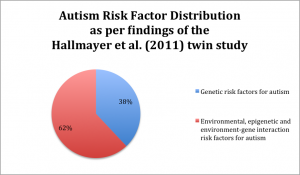Three research groups– Berry-Kravis et al. (2012), Jung et al. (2012),and Silverman et al. (2012)—have recently reported testing treatments for fragile X syndrome autism symptoms of social avoidance and anxiety.
Treatments could be of value because between 5% to 20% of individuals with autism symptoms has been found to have fragile X syndrome. Fragile X syndrome occurs in only 1 in 3000 individuals.
WHAT IS FRAGILE X SYNDROME?
Humans have about 22,000 genes. Genes are made of DNA and occur in 23 pairs of chromosomes. The 23rd pair is the sex chromosome pair: XX in females and XY in males.
DNA has 4 bases: A, adenine, which pairs with T, thymine; and C, cytosine, which pairs with G, guanine. The DNA genetic code is stored in a sequence of three bases called base triplets. The triplets direct a stage in the creation of proteins.
Fragile X syndrome results from an abnormally excessive 200 or more repeats of cytosine-guanine-guanine (CGG) triplets in the fragile X mental retardation 1 (FMR1) gene on the X chromosome. A typical/normal range of repeats is less than 50.
HOW DOES THE FRAGILE X SYNDROME CAUSE AUTISM SYMPTOMS?
Excessive repeats lead to a lack of fragile X mental retardation protein (FMRP) in the brain. Because the FMR1 protein inhibits protein synthesis, the lack of FMRP results in too much protein synthesis, causing an abnormal increase in dendritic spines on neurons in the brain.
The reduced FMRP of fragile X syndrome is also linked to abnormal regulation of two core neurotransmitters in the brain: glutamate and GABA. Glutamate is an excitatory neurotransmitter. Normal glutamate function and adequate dendritic spine plasticity are crucial for learning and memory. Normal GABA function is crucial for regulating anxiety and damping down social avoidance.
Thus the abnormal structure and function of neuron dendrites, and the dysregulated operation of glutamate and GABA are thought to cause the symptoms of fragile X syndrome: intellectual disability, anxiety, seizures, and social interaction impairment.
TREATMENT 1: INCREASING INHIBITORY GABA B RECEPTOR FUNCTIONING
Berry-Kravis et al. (2012) compared the effects of placebo pills to a drug called STX209 that increased the functioning of GABA B receptors. In 63 individuals with Fragile X syndrome the drug STX209 did reduce social avoidance but did not reduce irritability or aggression.
The researchers believe the drug increased the balance between excitatory (glutamate) and inhibitory (GABA) neurotransmission and could help ameliorate social avoidance in individuals with fragile X syndrome and in individuals with autism symptoms without fragile X syndrome.
TREATMENT 2: REDUCING ABNORMAL EXCITATORY RECEPTOR SIGNALING
Silverman et al. (2012) treated a mouse model of fragile X syndrome with a drug that could reduce the abnormally increased signaling of a specific receptor for the excitatory neurotransmitter glutamate. The name of the receptor is the metabotropic glutamate receptor subtype 5 or mGluR5.
The researchers found that when the fragile X syndrome mice were treated with the drug the mice showed increased normal social sniffing of other mice, and also showed a reduction in their abnormally excessive self-grooming.
TREATMENT 3: INCREASING NEUROMODULATORY ENDOCANNABINOID
Jung et al. (2012) explored a mouse model of fragile X syndrome, and investigated the context of the abnormally increased signaling of the metabotropic glutamate receptor subtype 5 (mGluR5) treated in the Silverman et al. (2012) study.
Jung et al. (2012) found that the abnormal mGluR5 signaling was associated with impaired endocannabinoid-dependent long-term depression. LTP, long-term potentiation is increased transmission of activation from one neuron to the next, and LTD, long-term depression, is decreased transmission of activation from one neuron to the next. Both LTP and LTD are crucial for learning, memory and consequently for establishing flexible behaviors.
A signalosome is a set of proteins that together regulate protein degradation.
The active element of the cannabis sativa or marijuana plant is tetrahydrocannabinol or THC. THC binds to the existing neuron receptors for the cannabinoids that circulate in the brain naturally. Two important endocannabinoids that occur as neuromodulators in our brains are anandamide and 2-arachidonoylglycerol or 2-AG. They function in the regulation of appetite, pain-sensation, mood, and memory.
Jung et al. (2012) did not explicitly propose that individuals with fragile X syndrome or autism would become more social if they were treated with marijuana or its active ingredient, tetrahydrocannabinol (THC). However, Jung et al. (2012) reported evidence suggesting the fragile X mental retardation protein regulates endocannabinoid 2-AG signaling at excitatory synapses that, in turn, causes long-term depression—a modulation of an excitatory synapse. The researchers demonstrated that the reduced FMR protein in the brains of fragile X mice caused a reduction in long-term depression dependent on 2-AG at excitatory synapses.
Jung et al. did suggest that therapy that could normalize the 2-AG receptor system might address fragile X and autism symptoms. The researchers concluded that their findings identified “the endocannabinoid signalosome as a molecular substrate for fragile X syndrome, which might be targeted by therapy.”
CAUTIONS REGARDING ALL THREE POTENTIAL TREATMENTS
First, the treatments proposed would each affect a wide range of synapses, not just brain circuits hypothesized to give rise to autism social communication impairments.
Second, it is not yet completely clear how many individuals diagnosed with autism (5-20%) do have fragile X syndrome, and it is not clear that individuals diagnosed with autism who do not have fragile X syndrome would experience behavioral improvement when given a drug that targeted fragile X brain dysfunction.
Third, all three studies reveal the complexity of downstream processes that are impaired by the absence of sufficient FMR1 protein. So many neuromolecular processes are occurring, addressing one component of a complex process by drug administration may have only short-term or minimal effectiveness.

